人教版新目标英语七年级下册unit_6_I_am_watching_TV._section_A_part_1
人教新目标七年级英语下册Unit6 I'm watching TV单词短语及重点句型

人教新目标七年级英语下册Unit6 I'm watching TV单词短语及重点句型Key Phrases重点短语1.watch TV 看电视2.read a newspaper 看报纸3.talk on the phone 通过电话交谈4.listen to a CD 听CDethe computer 使用电脑6.make soup 做汤7.wash the dishes 清洗餐具 8.tomorrow evening 明天晚上9.make dinner 做晚饭 10.eat out 出去吃饭11.go to the movies 看电影 12.drink tea 喝茶13.in a pool 在(游泳)池里 14.in the United States 在美国15.Dragon Boat Festival 端午节 16.make zongzi 包粽子17. host family 寄宿家庭 18.any other night 其他任何一个晚上19. living room 客厅 20. watch the boat races on TV 看电视上的龙舟比赛21. no place like home 没有像家一样的地方Key Sentences 重点句型1.That sounds good.那听起来不错。
2.Hello? This is Jenny.喂? 我是妮。
3.Hi,Jenny.It's Laura here.嗨,珍妮,我是劳拉。
4.What are you doing? 你在干什么?5.Not much. I'm just washing my clothes.没做什么。
我只是在洗衣服。
6.Do you want to join me for dinner? 你想跟我一起吃晚饭吗?7.Let's meet at my home first. Come at half past six.我们先在我家见面。
人教新目标七年级英语下册:Unit6 I'm watching TV.知识点总结及单元测验
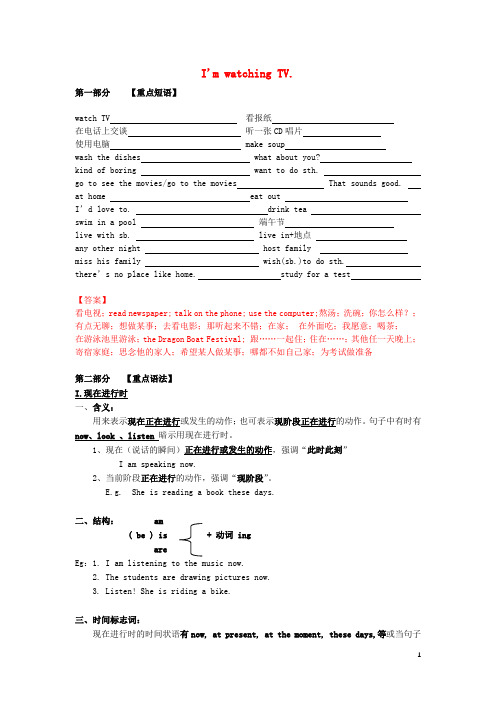
I'm watching TV.第一部分【重点短语】watch TV 看报纸在电话上交谈听一张CD唱片使用电脑 make soupwash the dishes what about you?kind of boring want to do sth.go to see the movies/go to the movies That sounds good. at home eat outI’d love to. drink teaswim in a pool 端午节live with sb. live in+地点any other night host familymiss his family wish(sb.)to do sth.there’s no place like home. study for a test【答案】看电视;read newspaper; talk on the phone; use the computer;熬汤;洗碗;你怎么样?;有点无聊;想做某事;去看电影;那听起来不错;在家;在外面吃;我愿意;喝茶;在游泳池里游泳;the Dragon Boat Festival; 跟……一起住;住在……;其他任一天晚上;寄宿家庭;思念他的家人;希望某人做某事;哪都不如自己家;为考试做准备第二部分【重点语法】1、现在(说话的瞬间)正在进行或发生的动作,强调“此时此刻”I am speaking now.2、当前阶段正在进行的动作,强调“现阶段”。
E.g. She is reading a book these days.二、结构: am( be ) is + 动词 ingareEg:1. I am listening to the music now.2. The students are drawing pictures now.3. Listen! She is riding a bike.三、时间标志词:现在进行时的时间状语有now, at present, at the moment, these days,等或当句子【练习】I.写出下列动词的现在分词play________ sing ________ go_________ swim _________ read________ eat write________ have________ make_______ swim _________ dance_______ live_________ ride live_______ take_________ come ________ put_________ cut run_________ sit _______showII.用所给的动词的正确形式填空1.The boy __________________ ( draw)a picture now.2. Listen!Some girls _______________ ( sing)in the classroom .3. My mother _________________ ( cook )some nice food now.4. Look . They _______________( have) an English lesson .5.They ____________(not ,water) the flowers now.6.Look! The girls ________________(dance )in the classroom .7.What is our granddaughter doing? She _________(listen ) to music.8. It’s 5 o’clock now. We _____________(have)supper now.9.______Helen____________(wash )clothes? Yes ,she is.10. What _____ you ______ ( do ) now?【答案】1.is drawing 2.are singing 3.is cooking 4.are having 5.aren’t watering6.are dancing7.is listening8.are having9.Is washing 10.are doing五、结构变型①陈述句(肯定句)主语+be(am, is, are)+现在分词,I am running.②一般疑问句Be(Am, Is, Are)+主语+现在分词,-Is he (she) listening to music?-Yes, he (she) is. / No, he (she) isn't.③特殊疑问句疑问词+be (am, is, are)+主语+现在分词,-What are you doing?-I am doing my homework.④否定句主语+be(am, is, are)+not+现在分词I am not reading English.下面以talk为例来说明其各种句式。
七年级英语下册Unit6I’mwatchingTV知识点详解素材人教新目标版(new)

Unit 6 I'm watching TV1.现在进行时态:(1)。
谓语动词:be + V-ing1).be动词要受主语影响变为am, is, are。
2).V-ing又叫现在分词。
(2)。
现在分词的构成规则如下:1)。
一般动词后直接加-ing.如:reading, watching, seeing2). 以不发音的e结尾的词去掉e再加—ing。
如: make—making write—writing3)。
以重读、闭音、单辅音字母结尾的词,双写这个辅音字母,再加—ing.如:get—getting swim—swimming put—putting run-running(3)用法:1)表示现在(说话瞬间)正在进行或发生的动作。
(不能指状态。
)2)表示现阶段正在进行,而此刻不一定在进行的动作。
(以these days为代表)3)表即将发生的动作。
这类词有:come, go, leave, arrive等,常与表将来的时间状语连用。
(4)常见标志:1)句中有:now, hear, look等。
如:He is doing his homework now.Look, what is the girl drawing?2)。
含现在进行时的问答。
如:—-Are you mending your pen? –No, I’m mending my bike。
你正在修笔吗?不,我正在修我的自行车。
3)用现在进行时回答表特殊的地点:如:——Where’s Tom?–He is washing clothes. (即在洗衣服的地方可找到他。
) 4)前句是“It's + 时间”句子。
如:It’s six o’clock now。
Jim is having supper.(5)。
现在进行时的一般疑问句及回答:一般疑问句把be动词提前;回答用Yes,主语+be或No, 主语+be+not。
如:Are you making the bed? Yes, I am.Is the girl drawing a picture? No, she isn't。
初中英语七年级下册Unit 6 I'm watching TV课件

嗯,没什么事。
3. Do you want to join me for dinner? 你想跟我一起吃个饭吗? join sb for something 表示“与某人 一起做某事;参与或加入到某人的行 列中一起做某事”。例如: e.g. Can you join us for lunch? 你能和我们一起吃午饭吗
Laura: Yeah. I’d love to. Jenny: Let’s meet at my home first.
Come at half past six. Laura: OK. See you then.
1. This is Jenny. 我是詹妮。 这是打电话用语。当打电话时,介绍自己时 用“This is…”或“It’s…”;问对方用“Is that…?”或“Who’s that?”例如: Hello? This is Bob? Who’s that? 喂?我是鲍勃,你是谁? Hi, Bob. It’s Mike here. 你好,鲍勃。我是迈克。
Answers I'm watching TV. She's washing her clothes. They are listening to a CD.
Are you doing your homework?
Yes,I am./No,I'm not.I'm cleaning my room.
Is he reading a newspaper?
Practice
阅读Grammar Focus部分,完成下列句子。
Yes,he is./No,he isn't.He's playing basekeball.
初中英语人教新目标七年级下册Unit 6 I’m watching TV单元知识点整理

七年级英语下册Unit6知识点【Useful expressions】1.read a newspaper/book 看报/读书2.talk on the phone 通过电话交谈3.make soup 煲汤4.wash/do/ the dishes 洗碗5.at home 在家6.eat out 外出就餐7.I'd love to=I would love /like to 我愿意/我想8.see you then. 再见9.wash the clothes 洗衣服10.make dinner 做饭11.drink tea 喝茶12.go to the movies 看电影13.think about/think of ...认为、考虑......14.live with... 和......居住在一起15.in the United States 在美国16.Dragon Boat Festival 端午节17.on TV 在电视里18.any other+可数名词单数其他任何一个19.read sth.to sb. 读......给......听20.wish to do sth 希望做......21.a lot=very much 非常22.talk show 脱口秀23.write about... 写关于......24.study for a test 复习迎考25.host family 寄宿家庭26.on the Internet 通过互联网e the computer用电脑28.Not much 没什么29.miss one’s family 想家30.at school 在学校【Target sentences】1.—What are you doing?—I’m watching TV.2.—What’s John doing?—He’s washing the dishes.3.— What are Dave and Mary doing?—They’re listening to a CD.4.— Where is he swimming?— At/In the pool.5.— Is she shopping?— Yes, she is.6.— Is he doing his homework?—No, he isn’t.7.—Are you doing your homework?—No,I'm not.I'm cleaning my room.8.Do you want to join me for dinner?9.What do you think of his home in China?10.His dad and uncle are watching the boat races on TV.11.The mother is reading a story to her young children.12.He's talking on the phone to/with his cousin in Shenzhen.13.Zhu Hui misses his family and hopes to have his mom's delicious zongzi.14.But there's still no place like homehome.15.Zhu Hui loves New York and his host family a lot.【Language points】1.He is reading a newspaper.newspaper n.报纸为可数名词,“看报纸”要用read a newspaper.【易混辨析】in the newspaper与on the newspaperLook! Your photo is in the newspaper.看!你的照片上报纸了。
七年级英语下册_Unit_6_I’m_watching_TV学案_人教新目标版
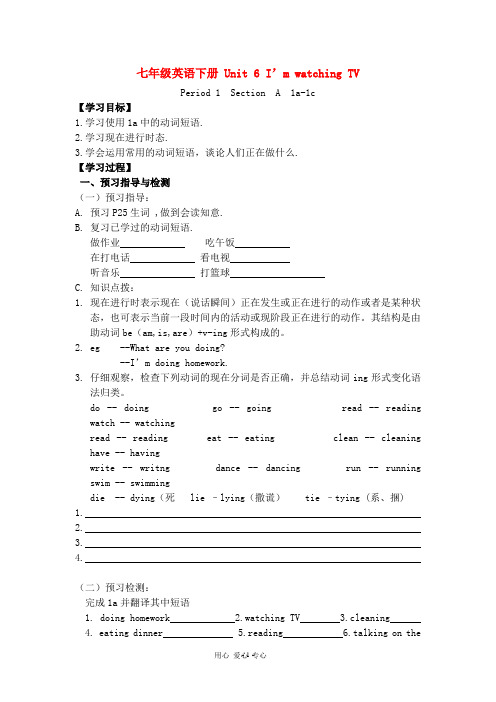
七年级英语下册 Unit 6 I’m watching TVPeriod 1 Section A 1a-1c【学习目标】1.学习使用1a中的动词短语.2.学习现在进行时态.3.学会运用常用的动词短语,谈论人们正在做什么.【学习过程】一、预习指导与检测(一)预习指导:A.预习P25生词 ,做到会读知意.B.复习已学过的动词短语.做作业吃午饭在打电话看电视听音乐打篮球C.知识点拨:1.现在进行时表示现在(说话瞬间)正在发生或正在进行的动作或者是某种状态,也可表示当前一段时间内的活动或现阶段正在进行的动作。
其结构是由助动词be(am,is,are)+v-ing形式构成的。
2.eg --What are you doing?--I’m doing homework.3.仔细观察,检查下列动词的现在分词是否正确,并总结动词ing形式变化语法归类。
do -- doing go -- going read -- readingwatch -- watchingread -- reading eat -- eating clean -- cleaninghave -- havingwrite -- writng dance -- dancing run -- runningswim -- swimmingdie -- dying(死 lie –lying(撒谎) tie –tying (系、捆)1.2.3.4.(二)预习检测:完成1a并翻译其中短语1. doing homework2.watching TV3.cleaning4. eating dinner5.reading6.talking on thephone二、课堂互动探究1.Pairwork: 使用句型What are you doing? I’m…谈论正在进行的动作。
2.得分小能手:看谁能用现在进行时态造句,并造的又多又准确,注意动词ing的结构哟。
新目标七年级英语下Unit6 第一课时I'm_watching_TV.
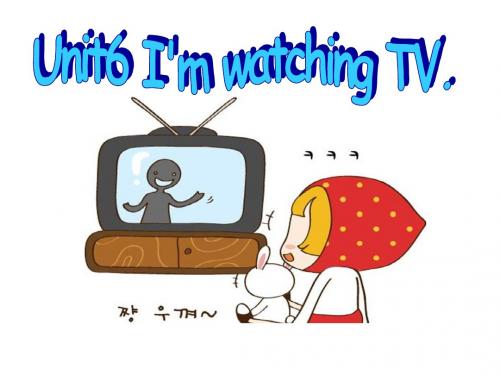
1a Match the activities with the pictures.
1.watching TV ___ 2.cleaning ______
3.reading a newspaper___
4.talking on the phone ___ 5.listening to a CD ____ ing the computer ____ 7.making soup ______
reading a newspaper
A: What are you doing now? B: I am _______.
washing the dishes
A: What are you doing now? B: I am _______.
listening to a CD
A: What are you doing now? B: I am _______.
They play basketball every day.
1c Ask and answer questions about what people are doing in 1a.
A: What’s he doing? B: He’s using the computer. A: What are they doing? B: They’re listening to a CD.
making soup
A: What are you doing now? B: I am _______.
talking on the phone
A: What are you doing now?
B: I am _______.
A: What ___ ____ doing now? B: ____ _____ _______.
初中英语《Unit6 Iam watching TV》主题单元教学设计以及思维导图

Unit6Iam watching TV5.学生能独立完成Unit6的单元综合测试。
主题单元规划思维导图主题单元学习目标本专题的主要学习设计活动如下:1、创设问题情景,导入对话交流。
师生对话,导入问题如下:“What are you doing? What’she/he doing? Is he/she…?”提问第1个问题以前,利用多媒体呈现几张动作图片:2、开展阅读活动,实现生本对话。
A.阅读语篇,回答问题。
引导学生运用Skimming阅读方法,快速获取答案。
B. 再读语篇,选择段落大意。
引导学生运用Scanning阅读方法,快速获取有效信息。
新文段的补充,使学生认识到英语学习材料的丰富性,感受英语学习的乐趣。
在阅读过程中,学生的预测、略读、跳读及布局谋篇、遣词造句等技能再次的得到训练和提高。
C.再读文段,画出主要话题功能句。
在语篇情景中,完成对主要功能句的复习和梳理。
学生充分体验归纳、概括等识记策略。
D.提出问题,构建篇章结构。
针对老师提出的问题,学生首先独立思考,之后开展研究性学习,进行小组合作探究。
共分7个小组。
组内异质,组间同质。
3、依据篇章结构图,进行文段复述。
A. 自主朗读,熟悉语篇。
B.小组内复述。
C.小组代表向全班同学复述。
学生在完成任务的过程中,再次感悟体验写作时的布局谋篇;在赏析语言的过程中,感悟遣词造句的方法。
4、借助文段仿写,运用所学,写出开放性写作。
(详见研究性学习设计)A. 自主学习:学生独立思考,完成书面表达任务的结构框架,写出所用词汇和主要功能句。
B.探究合作:基于独立完成的组内交流、修订,体现生生互助。
C.自主学习:依据讨论后修订的框架和所写词、句,自主完成书面表达。
D.再次合作探究:组内交流、修订,完善作品。
推荐出小组最佳征文。
E. 班级交流:各小组选出1名代表,到讲台朗读小组最佳征文。
老师及其他学生对最佳征文根据评价量规对其进行评价。
通过完成该任务,学生的综合语言运用能力,特别是写的能力得到提升,同时通过交流达成读写课中以读带写的目标。
人教新目标版2013—2014年度下学期七年级英语教案Unit 6 I’m watching TV.

人教新目标版2013—2014年度下学期七年级英语教案主备人:备课时间:2014年月日成员:Unit 6 I’m watching TV.一、Teaching Goal:In this unit students learn to talk about what people are doing. Teach students how to cooperate and be good at watching something and love our lives.二、Teaching difficulties1. The vocabulary and the sentence structures.2. Learn the grammar: Present progressive tense.3. Oral practice using the target language.三、Teaching MethodsListening and practicing methods, pair work, Task-Based Learning method.四、Teaching AidsA tape recorder, some pictures and cards.五、Teaching Time: 5 periodsPeriod 1 (Section A:1a—2b)Teaching ProceduresStep 1.Revision1. Greetings.2. Revise the words and expressions in Unit 4.Step 2.Presatation: Lead in1. Do “Ask and answer” practice with the Ss.2. The teacher asks the students to give more verbs phrases and write them down on the blackboard.(show many pictures to help the Ss.)Teach the new words and expressions.3. Teach the Present Progressive.1)Introduction: Talk about the title of this unit. Show some pictures to introduce the Present Progressive tense.T: What’s she/he doing?Ss: She/He is v-ing (Help the Ss to answer the questions and show the sentences)2) Let the Ss to say what the Present Progressive is.3). Tell the differenceWrite down the V-ing forms by another lines of go, watch, do, play and eat . Ask the Ss to have a look and find the difference between them. For example: go and going, watch and watching, do and doing, etc. Then ask the Ss to read them again and do more exercises.Step3.Activity 1a:Match1. Help the Ss talk about the pictures. The Ss read these V-ing wordsafter the teacher. Match the words and the activities. Check the answers.2. Help the Ss do “Ask and answer” practice in pairs.3. Ask some Ss to do actions and let the class guess what he/she is doing.Step4.Activity 1b & 1c: Listening and pair work.1. Play the recording for the Ss to listen. Play again. Ss listen and write the number of the activity each person is doing. Check the answers.2. Pairwork: Ask the Ss to do “Ask and answer” practice about the picture in pairs. Some pairs present their dialogues to the class.Step 5.Activity 2a & 2b: Listening and Practice1.Activity 2a:Talk about the picture in 2b.Ask the Ss to read the questions in 2a. Then listen to the tape and and write the answers. Check the answers.2.Activity 2b:Play the recording again. Help the Ss put these questions and answers in order to make a conversation. Go through the answers with the Ss.Step 6 Pairwork: Activity 2c1.Talk about the pictures in 2c. Ask Ss to read the sample conversation. Let Ss look at the first group of pictures, and ask them to guess what the people are doing.2. Then imitate the sample conversation, work in pairs. Some pairs present their dialogues to the class.3. A guessing game: Guess the activities according to the Ss’ actions.Step 7 Homework: 1.Copy the new words and recite.2.Make up their own dialogues.教学后记:Period 2 (Section A:2d—3c)Teaching aimsGo on learning to talk about what people are doing.Language points1.To learn the following sentences.⑴—Is Nancy doing homework ?—Yes, she is ./No, she isn’t .She is writing a letter.⑵—Do you want to go to the movies? —Yes ,I do .⑶—When do you want to go? —Let’s go at six o’clock.2.To learn the following words and phrases:⑴adjective: sure⑵verb phrases: wait for , talk about , talk to sb.Teaching difficultiespresent participle: run-running , write-writing Present progressive tense: Subject +be+doing +…Teaching stepsWarming-up and revision⑴Watch VCD which is connected with the present progressive tense.⑵RevisionThe teacher asks Ss to do some actions, ask and answer one by one (chain work)T: What are you doing? S1: I am reading an English book. What are you doing ?S2: I am writing .What are you doing ? S3: I am playing the guitar. What are you doing?Show some pictures, point to them and ask.T: Look at picture 1! What is he /she doing ? S1: He/She is talking on the phone.T: Look at picture 2! What are they doing? S2: They are singing and dancing.T: Look at picture3. What is he doing? S3: He is swimming.2. PresentationThe teacher asks one student to come to the blackboard and do an action.T: Are you playing soccer? S: No, I’m not.T: Are you playing basketball? S : Yes, I am.Ask more students like this.PracticeHave students make a similar dialogue like thisS1: Are you reading a book? S2: No, I am not.S1: Are you reading a newspaper ? S2: Yes ,I am.4. Guessing gamesThe teacher uses pictures to ask the students. Cover one part of the picture and then uncover it little by little.T: What is he doing ? S1: Is he playing the computer?T: No, he isn’t . S2: Is he playing the guitar? (show another picture)What are they doing? Teacher continues to ask students and shows them more pictures.5. Pair work (work on 2c)T: let’s look at the pictures and guess what the people are doing. Please practise in pairs.A: Is Nancy writing a letter? B: No, she isn’t. She is writi ng a letter. Then check the answers.6. Work on 3aT: Look at the pictures and make conversations. Please write the correct number of the pictures next to the conversations below. Then check the answer. [Conversation A=3 Conversation B=2 ]The teacher reads the conversation before the class, and the Ss repeat the sentences. Ss practice the conversation in pairs and act out the conversation.7. Pair work(work on 3c)(1)Show a picture and teach the new phr ase“wait for a bus”.(2)Look at the pictures and answer the questions below. Ask Ss ask and answer like this.S1: Where is he? S2: He is in the store/ the supermarket.S1: What is he taking? S2: He is taking a bottle of juice.S1: What is he waiting for? S2: He is waiting for a bus.(3)T: Please look at the pictures again and talk about the four pictures.8. Grammar FocusWhat are you doing? What is he/she doing?I am watching TV. He is doing homework.Is he/she doing? Yes, he/she is./No, he/she isn’t/Are they doing? Yes, they are./ No, the y aren’t.9. HomeworkRead and recite 3a.Write the story about the four pictures.教学后记:Period 3 (Section B:1a-1e)Teaching aims询问别人正在哪里干某事. 继续学习某人正在干某事.Teaching pointsTo learn the following sentences.—Where do people play basketball? —At school.—Where is he swimming? —He is swimming at the pool.To learn the following vocabularies: toy, shopping, mall, pool.Teaching stepsWarming-up. chant and revisionChantWhat are you doing? I’m reading books.What is he doing? He is watching TV.What is she doing? She is doing homework.What are they doing? They are eating dinner.Revision Ask a student to do an action and askT: Are you eating breakfast? S1: No, I’m not .T: Are you singing? S2: Yes, I am .T: Is he writin g a letter? S3: No, he isn’t .T: What is she doing? S4: She is singing .T: Are you reading a newspaper? (To another student)S5: No, I’m not .T: What are you doing? S6: I am reading an English book .T: Is he reading a Chinese book? S7: No, he isn’t .T: Is she reading an English book? S8:Yes, she is .PresentationShow some pictures and present the new vocabularies .T: What is he doing?S1: He is swimming .T: Where is he swimming?S2: He is swimming in the river .T: No, he isn’t swimming in the river. He is swimming at the pool .T:Look! What are these? They are toys . What are the girl and her mother doing? They are shopping .T: Where are they shopping?S1: They are shopping in the store .S2: They are shopping in the supermarket .T: Maybe, look, they are shopping at the mall .PracticeShow some pictures and phrases, let Ss practice in pairs like this .A: What is he doing?B: He is boating .A: Where is he boating?B: He is boating on the river .Complete the chart . (work on 1a)T: Look at the pictures and complete the chart .Then check the answer .1). library reading books2). school playing basketball3). pool swimming4). mall shoppingPairworkLet Ss look at the chart , ask and answer in pairs .A: Where do people play basketball?B: At school .A: Where do people swim?B: At the pool .Listening comprehension2a. T: You will hear three short conversations. Please listen carefully and write down the places you hear in the chart below . Then check the answers: mall, school , library .2b. T: Now look at 1b on page 28. Please listen to the tape again and fill in the chart . Let’s write down what they are doing.Ss listen to the tape twice and write down the answer on their charts.7. Pairwork (work on 1c) .T: Now look at the chart and use the information in the chart to make a conversation like this .A: Hello! Is Tina there?B: No, she isn’t . She is at the mall .A: Oh, is he shopping at the mall ? / What is she doing ?B: No, she isn’t ./ She is eating lunch with a friend .8. Groupwork (Make a survey )1). T: Let’s make a survey, please ask Ss in your classroom where their parents are and what their parents doing now . Please ask and answer in threes, then fill in the chart .2.) After the Ss finish the survey .Let them give a report .9.Homework:1). Listen to the tape and repeat the conversation on Section B.2b.try to imitate the pronunciation and intonation.2). Collect some pictures and bring them to the classroom.3). Write the report down in the exercise book .教学后记:Period 4 (Section B:2a—2c)Teaching aims:Ss can use the present progressive tense to describe the pictures.Ss can ask and answer questions about the picture fluently.Language pointsTo use the following sentences:Here is a photo / picture of my family.I’m with my sister Gina.Thank you for your letter and the photosTo learn the following phrasesThank you for sth. / doing sth. be withTeaching difficultiesHow to write the sentences about the present progressive tense correctly.Teaching steps1.warming-up and revision(1)The teacher asks Ss some questions.T: Hello, how are you? S1: I’m great. Thank you.T: How is your father? S1: He is very well.T: Where is your father? S1: He is at the mall.T: What is he doing? S1: He is shopping.T: Is your father shopping now? S2: No, he isn’t. He is watching TV.T: Where is he watching TV? S2: He is watching TV at home.(2) Show some pictures, let Ss ask and answer the questions in pairs.S1: Look! What is she doing? S2: She is reading a book.S1: Where is she reading a book? S2: She is reading a book under a tree.2. Work on 3a.(1)Show the pictures of 3a and let Ss say it one by one.S1: He is playing basketball.S2: The girl is doing homework.S3: The boy is watching TV.S4: He is swimming.S5: They are eating and talking.(2) T: Here is a letter from Mike to his pen pal, Linda. Please read the letter and underline the activities and circle the places. Check the answers(3) T: Now read the letter again and number the photos, using 1,2,3,4.Check the answers: 1, 4, 2, 3(4) Let Ss work in pairs, ask and answer about the photos like this.A: What is Mike doing in Photo 1?B: He is playing basketball.A: Is he playing basketball at school?B: Yes, he is.3.WritingShow the pictures to the Ss and let Ss finish the sentences, then check the answers.They are dancing. He is running.Yao Ming is playing basketball.The teacher is writing. Xie Tingfeng is singing.4.Group workT: Now take out your photos or pictures, please work in fours and tell your partners about your pictures or photos. I’ll give you two minutes to practice it.T: At this time I’ll ask several students to say something about your photos.5. PracticeT: Take out the pictures or photos of your own and write one or two sentences about them.Ss write the sentences in their exercise books, the teacher walks around the class and see if the Ss can write the sentences correctly. Give Ss some help if necessary.The teacher collects some pictures and sentences, shows them to the Ss and checks the answers.6. Fill in the blanks. ( finish 2b)(1) T: Here is another photo, look at the photo and the letter next to it. Please take out your pens and fill in the blanks. Check the answers: watching TV reading the newspaper talking eating(2)Show the picture of 2b, let Ss say the picture like this:7. Homework.Write a short composition about your own photos or pictures.教学反思:Period 5 (3a-Selfcheck)Teaching aims:Revise the contents of Unit 6.Ss can use the present progressive tense correctly.Language pointsRevise the key words, phrases and sentences in this unit.To learn two new words: camera, birdKey points and teaching difficulties.Consolidate the present progressive tense.Teaching steps:Step 1 Warming-up and revisionLet one student take out a photo or a picture of his / her own and show it to the whole class, then he / she will ask some questions about the photo or the picture.S1: Where is my father?S2: He is…..S1: What is he doing?S3: He is…S1: Is my mother doing…?S4: No, she isn’t. She is …Ask more Ss to come to the blackboard to do it.Step 2 PresentationUse two pictures and present the new words: camera, birdT: What is this?S1: Sorry, I don’t know.T: It’s a camera. We can use a camera to take a photo.T: Look! What is it? S2: It’s a bird.T: That’s right. What is the bird doing?S3: I think it is singing.S4: I think it is flying.Step 3 Complete the storyT: Look at the pictures on Page 30, Part 3. please complete the story and write the sentences in the blanks.Check the answers:What is he doing? He is looking at the birds.What are they doing? They are talking.What is the boy doing? He is running.What is the boy carry? He is carrying a bag.What is in the bag? It’s a camera.What is the boy doing? He is taking a photo.Step 4 Divide the Ss into two parts and read the dialogue. Let Ss act out the dialogue.Step 5 Key words checkStep 6 HomeworkReview the key words and phrases.教学后记:。
人教版新目标Unit6-I'm-watching-TV知识点_

人教版新目标Unit6-I'm-watching-TV知识点Unit6 I’m watching TV一、词组、短语及用法1.do one’s homework (此处的do是“做”的意思)2.talk on the phone 打电话交谈3.watch look see read 的大致区别:watch 观看,看watch TV 看电视watch a football game 看一场足球比赛see 看见(看的结果)I can see the bird in the tree.look 看(看的动作)Please look at the blackboard.read 阅读,读书,读报She is reading a story.4.go to the movies 去看电影5.That sounds good. 那听起来不错 show 电视节目7.at six o’clock 在六点钟8. wait for sb /sth 等侯某人/某物9. all 、also 、often 、never 等副词应该放在be动词,情态动词及助动词之后,行为动词之前。
He never stop talking. I often get up at six.We are all students. The boys can also swim.They all like English. Lions also come from South Africa.(1)-What+be+主语+doing? 正在做什么?-主语+be+doing… 正在做某事。
例:-what are you doing?—I’m doing my homework.(2)-Thanks for … 为。
而感谢例:Thanks for your letter.(3)-Here are/is…例:Here are some of my photos.Here is a photo of my family.(4)-That sounds good.(5)-This TV show is boring.三、重点句式1.他正在干什么?What is he doing?他正在吃饭He is eating dinner.他正在哪里吃饭?Where is he eating dinner?他正在家里吃饭He is eating dinner at home.2.你想什么时候去?When do you want to go?让我们六点钟去吧。
七年级英语下册 Unit 6 I’m watching TV学案 (新版)人教新目标版-(新版)人教
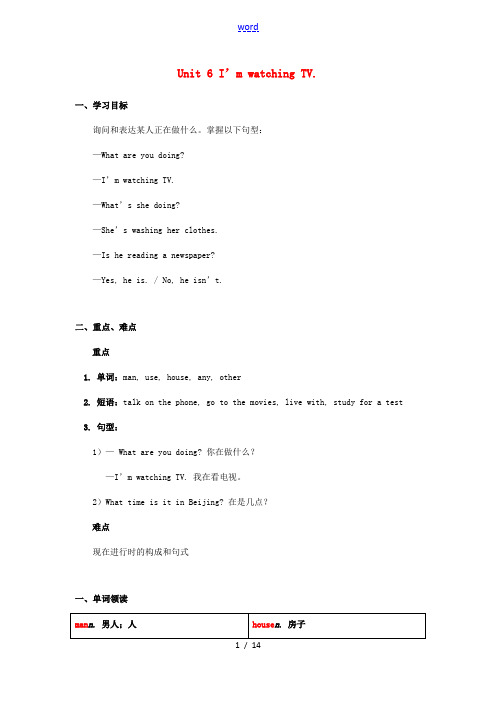
Unit 6 I’m watching TV.一、学习目标询问和表达某人正在做什么。
掌握以下句型:—What are you doing?—I’m watching TV.—What’s she doing?—She’s washing her clothes.—Is he reading a newspaper?—Yes, he is. / No, he isn’t.二、重点、难点重点1. 单词:man, use, house, any, other2. 短语:talk on the phone, go to the movies, live with, study for a test3. 句型:1)— What are you doing? 你在做什么?—I’m watching TV. 我在看电视。
2)What time is it in Beijing? 在是几点?难点现在进行时的构成和句式一、单词领读use v.使用;运用other adj. 另外的;其他的pron.另外的人(或物)any adj.任何的;任一的pron.任何;任一二、重点单词【单词学习】☆☆1. use v.使用;运用【用法】及物动词。
【例句】—Can I use your bike? 我可以用一下你的自行车吗?—Sure. 当然可以了。
【拓展】(1)use n.用法;使用;用途(2)useful adj.有用的;有益的(3)useless adj.无用的【例句】He makes good use of his time. 他充分利用他的时间。
English is useful to you. 英语对你来说有用。
Why do you think it’s useless? 你为什么认为它没用呢?【考题】Can you help me ______ the puter? I think it’s very _______.A. use; usefulB. to use; uselessC. useful; useD. use; useless答案:A思路分析:help sb. (to) do sth.,故C项错误;根据前句“你能帮助我使用电脑吗?”可知“我认为它是很有用的”,故用useful。
七年级下册Unit6《I’mwatchingTV》教学设计
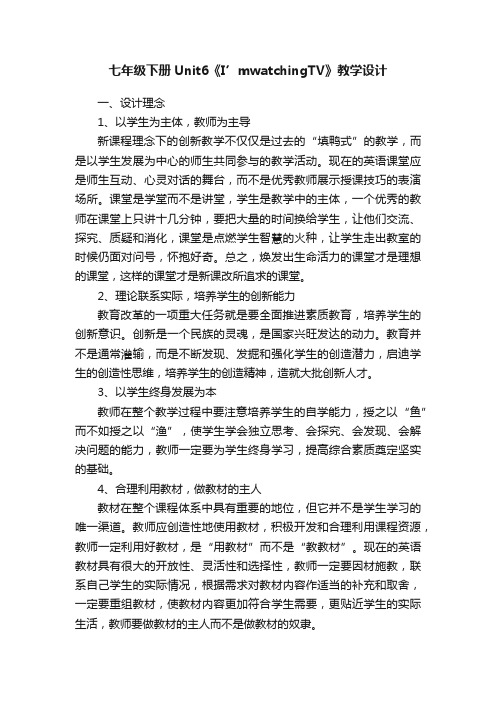
七年级下册Unit6《I’mwatchingTV》教学设计一、设计理念1、以学生为主体,教师为主导新课程理念下的创新教学不仅仅是过去的“填鸭式”的教学,而是以学生发展为中心的师生共同参与的教学活动。
现在的英语课堂应是师生互动、心灵对话的舞台,而不是优秀教师展示授课技巧的表演场所。
课堂是学堂而不是讲堂,学生是教学中的主体,一个优秀的教师在课堂上只讲十几分钟,要把大量的时间换给学生,让他们交流、探究、质疑和消化,课堂是点燃学生智慧的火种,让学生走出教室的时候仍面对问号,怀抱好奇。
总之,焕发出生命活力的课堂才是理想的课堂,这样的课堂才是新课改所追求的课堂。
2、理论联系实际,培养学生的创新能力教育改革的一项重大任务就是要全面推进素质教育,培养学生的创新意识。
创新是一个民族的灵魂,是国家兴旺发达的动力。
教育并不是通常灌输,而是不断发现、发掘和强化学生的创造潜力,启迪学生的创造性思维,培养学生的创造精神,造就大批创新人才。
3、以学生终身发展为本教师在整个教学过程中要注意培养学生的自学能力,授之以“鱼”而不如授之以“渔”,使学生学会独立思考、会探究、会发现、会解决问题的能力,教师一定要为学生终身学习,提高综合素质奠定坚实的基础。
4、合理利用教材,做教材的主人教材在整个课程体系中具有重要的地位,但它并不是学生学习的唯一渠道。
教师应创造性地使用教材,积极开发和合理利用课程资源,教师一定利用好教材,是“用教材”而不是“教教材”。
现在的英语教材具有很大的开放性、灵活性和选择性,教师一定要因材施教,联系自己学生的实际情况,根据需求对教材内容作适当的补充和取舍,一定要重组教材,使教材内容更加符合学生需要,更贴近学生的实际生活,教师要做教材的主人而不是做教材的奴隶。
5、注重面向全体学生,构建和谐课堂由于学生之间的个性差异,每个班级都有两极分化现象。
针对这种情况,教师的眼睛不能只盯着几个优生,要面向全体学生。
教学的内容要满足各个层次的学生,特别要关注学困生。
七年级英语下册《Unit6IamwatchingTV》教案(新版)人教新目标版

Unit 6 I am watching Tv知识目标:一、Learn the new words and ph rases:1.Newspaper2.read a newspapere4.soup5.make soup6.wash7.movie8.go tomovie s9.just 10.eat out二、掌握下列句型:What are you doing? I’m watching TV.What is he doing ? He is washing his cl othes.What is she doing ? She is washing her clothes.What are they doing? They are listening to a CD.Is he washing hi s clothes? No, he isn’t. He is playing basketball.能力目标: 1.能够掌握现在进行时态的用法。
2. 能够掌握w hat 引导的特殊疑问句。
情感目标:谈论自己和他人正在做的事情。
教学过程:●Step 1: Show some pictures(PPT) to learn some new words:1.newspaper2.read a newspapere4.soup5.make soup6.wash7.movie8.go to movies9.just 10.eat out●Step2: learn 1a: Match t he activities with the people.First read the words, then match.Check the answers. 1--.i 2—d3—g4—a(i), 5—h ,6—e ,7—b; 8.---c 9--f●Step3.Presentation Learn the following sentences by PPT:1. What are y ou doing? I’m watching T V.2.What is he doin g ? He is washing his clothes.3.What is she doing ? She is washing her clothes.4. What are they doing? The y are listening to a CD.5.Is he washing his clothes? No, h e isn’t. He is playing basketball.●Step4: Listen to 1b and number the conversations.First let the Ss listen carefully.. Then check the answers. a—1; b---8; c----5 ●Ste p5: Pairwork:According to 1b—Practice the conversations like t his:A: What is he doing ?B: He’s using the computer.A: What are they doing?B: They are listening to a CD.●Step6: Listening 2aListen to 2a and match the answers.Check the●Step7:Lis tening:Listen again. Complete the sentences.are doing; watching TV ; listening toa CD ; boring; interesting; go to●Step8: Role- play the conversation in 2b●Step 9: Summary1. What are you doing? I’m watching TV.2.What is he doing ? He is washing his clothes.3.What is she doing ? She is washing her clothes.4. What are the y doing? They are listening to a CD.5.Is he wa shing his clothes? No, he isn’t. He is playing basketball.●Step10. Test1. Who _____ over there now?A. singingB. are singC. is singingD. sing2. It’s eight o’clock. The students _____ an English class.A. haveB. havingC. is havingD. are having3. Listen! The baby _____ in the next room.A. cryingB. criedC. is cryingD. cries4. Look! The twins _____ new sweaters.A. are wearingB. wearingC. are wearD. is wearing5. Don’t talk here. Grandparents _____.A. is sleepingB. are sleepingC. sleepingD. sleep教学后记:学生学习积极性较高,对于所学知识掌握较好。
七年级英语下册Unit6I’mwatchingTV同步语法素材2人教新目标版(new)

I’m watching TV。
(1)现在进行时的肯定句型.主语+am/is/are+现在分词+…I am watching TV now。
我现在正在看电视。
She is washing the dishes。
她正在洗碟子。
They are playing games。
他们正在做游戏。
(2) 现在进行时的否定句型。
主语+ be + not+现在分词+…He isn’t watching TV. 他没在看电视。
I am not cooking。
我没有在做饭。
We aren’t h aving English class. 我们没在上英语课.(3) 现在进行时的一般疑问句型。
be+主语+现在分词+…Are you dancing?你们正在跳舞吗?Is he drawing a picture? 他正在画一张画吗?Are you talking with your friend? 你正在和你的朋友谈话吗?现在进行时一般疑问句的答语:①肯定回答:Yes, 主语 + be动词②否定回答:No, 主语 + be动词+not.— Are you listening to the music? 在听音乐吗?— Yes,I’m/No, I am not. 是的,我正在听。
/不,我没在听. (4)现在进行时的特殊疑问句型特殊疑问词+be动词+主语+现在分词+……What are you doing? 你正在做什么?Who is singing a song?谁在唱歌?Why are they cleaning their room?他们为什么在打扫房间呢?尊敬的读者:本文由我和我的同事在百忙中收集整编出来,本文档在发布之前我们对内容进行仔细校对,但是难免会有不尽如人意之处,如有疏漏之处请指正,希望本文能为您解开疑惑,引发思考。
文中部分文字受到网友的关怀和支持,在此表示感谢!在往后的日子希望与大家共同进步,成长。
This article is collected and compiled by my colleagues and I in our busy schedule. We proofread the content carefully before the release of this article, but it is inevitable that there will be some unsatisfactory points. If there are omissions, please correct them. I hope this article can solve your doubts and arouse your thinking. Part of the text by the user's care and support, thank you here! I hope to make progress and grow with you in the future.。
【人教版新目标】初一七年级英语下册《Unit 6》单元教案
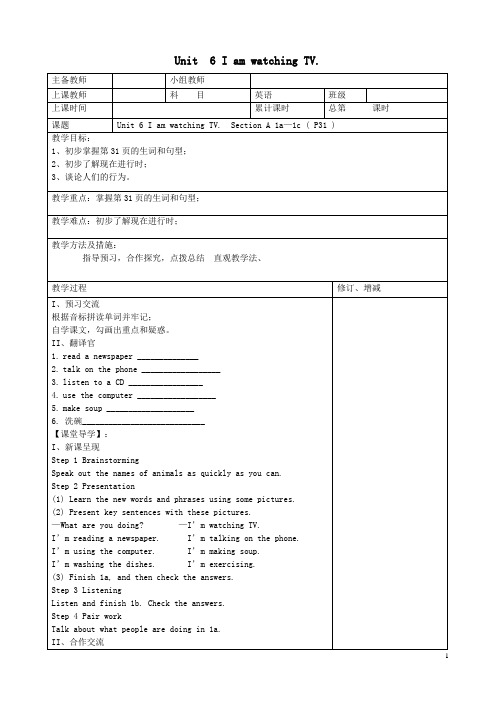
We can eat out. Come at half past six.
Step 3 Listening
Listen and finish 2a and 2b. Check the answers.
Step 4 Pair work
勾画出重点和疑惑。
II、翻译官
1.now _________________2. on Mondays ____________________
3. every night_____________4. in the mornings_____________
5. clean the house____________6. make dinner____________________
()3. The students are _________ the teacher.
A. listen to B. listening to C. listening
()4. The girls _______ in the classroom.
A. sings B. singing C. are singing
A. meet B. to meet C. meeting
II、补全对话
Tom:Hello? (1)_______________________________
Jack:Hi, Tom. It’s Jack here.
Tom:Hi, Jack! (2)_____________________________
A. Are you reading; read B. Do you read; read
初中英语《Unit6 Iam watching TV》主题单元教学设计以及思维导图

Unit6Iam watching TV5.学生能独立完成Unit6的单元综合测试。
主题单元规划思维导图主题单元学习目标本专题的主要学习设计活动如下:1、创设问题情景,导入对话交流。
师生对话,导入问题如下:“What are you doing? What’she/he doing? Is he/she…?”提问第1个问题以前,利用多媒体呈现几张动作图片:2、开展阅读活动,实现生本对话。
A.阅读语篇,回答问题。
引导学生运用Skimming阅读方法,快速获取答案。
B. 再读语篇,选择段落大意。
引导学生运用Scanning阅读方法,快速获取有效信息。
新文段的补充,使学生认识到英语学习材料的丰富性,感受英语学习的乐趣。
在阅读过程中,学生的预测、略读、跳读及布局谋篇、遣词造句等技能再次的得到训练和提高。
C.再读文段,画出主要话题功能句。
在语篇情景中,完成对主要功能句的复习和梳理。
学生充分体验归纳、概括等识记策略。
D.提出问题,构建篇章结构。
针对老师提出的问题,学生首先独立思考,之后开展研究性学习,进行小组合作探究。
共分7个小组。
组内异质,组间同质。
3、依据篇章结构图,进行文段复述。
A. 自主朗读,熟悉语篇。
B.小组内复述。
C.小组代表向全班同学复述。
学生在完成任务的过程中,再次感悟体验写作时的布局谋篇;在赏析语言的过程中,感悟遣词造句的方法。
4、借助文段仿写,运用所学,写出开放性写作。
(详见研究性学习设计)A. 自主学习:学生独立思考,完成书面表达任务的结构框架,写出所用词汇和主要功能句。
B.探究合作:基于独立完成的组内交流、修订,体现生生互助。
C.自主学习:依据讨论后修订的框架和所写词、句,自主完成书面表达。
D.再次合作探究:组内交流、修订,完善作品。
推荐出小组最佳征文。
E. 班级交流:各小组选出1名代表,到讲台朗读小组最佳征文。
老师及其他学生对最佳征文根据评价量规对其进行评价。
通过完成该任务,学生的综合语言运用能力,特别是写的能力得到提升,同时通过交流达成读写课中以读带写的目标。
人教版新目标七年级英语下册Unit6I’mwatchingTV语法篇试题含答案

人教版新目标七年级英语下册Unit6I’mwatchingTV语法篇试题熟练掌握本章重点语法知识。
按要求转换句型1. Her father is cooking the meal. (改为一般疑问句)her father the meal?2. My sister is washing clothes now. (改为一般疑问句并作肯定回答)your sister clothes now?, .3. She often plays soccer after school. (用now改写句子)She soccer now.4. The boys often play basketball after school. (对划线部分提问)the boys often after school?5. The teachers are watching TV in the meeting room. (对划线部分提问)in the meeting room?解析:1. 此题为现在进行时变一般疑问句,be动词应该提前,故答案为Is, cooking2. 此题为现在进行时变一般疑问句和肯定回答,be动词应该提前,故答案为Is, washing; Yes, she is3. 此题为一般现在时变现在进行时,故答案为is playing4.此题考察了一般现在时的特殊疑问句,故答案为 What do, do5. 此题考查了现在进行时的特殊疑问句,故答案为What are the teachers doing基础演练一、单项选择1. --- What are the kids doing?--- They the flowers in the garden.A. waterB. wateredC. have wateredD. are watering2. --- What's that noise?--- Bob and his sister computer games.A. have playedB. are playingC. playedD. will play3. He sometimes a picture, but now he .A. draw; singsB. drawing; singingC. draws; is singingD. is drawing; sings4. --- stories every day?--- No. But now I .A. Are you reading; readB. Do you read; am readingC. Do you read; readD. Are you reading; am reading5. --- Is Jack in the classroom now?--- No, he football on the playground.A. playsB. playedC. is playingD. was playing二、翻译(根据中文提示完成句子)6. 史蒂夫正在通过电话交谈。
人教新目标七年级英语下册Unit 6 I'm watching TV.基础知识汇总与默写清单

人教新目标七年级英语下册Unit 6 I'm watching TV.基础知识汇总与默写清单Section A【重点单词】1.newspaper n.报纸e v.使用;运用3.soup n.汤4.wash v.洗5.movie n.电影6.just adv.只是;恰好7.house n.房子8.drink v.喝n.饮料9.tea n.茶;茶叶10.tomorrow adv.在明天n.明天;未来【单词变形】1.newspaper—newspapers(复数)2.house—houses(复数)3.movie—movies(复数)4.make—makes(第三人称单数)—making(现在分词)5.wash—washes(第三人称单数)—washing(现在分词)e—uses(第三人称单数)—using(现在分词)7.drink—drinks(第三人称单数)—drinking(现在分词)8.watch—watches(第三人称单数)—watching(现在分词)【重点短语】e the computer使用电脑2.make soup做汤3.wash the dishes清洗餐具4.kind of有点儿5.go to the movies去电影院6.not much没什么事7.watch TV看电视8.read a newspaper看报纸9.talk on the phone通电话10.listen to…听……11.wash one's clothes洗某人的衣服12.join sb.for sth.加入某人一起做某事13.at home在家14.eat out出去吃饭15.at one's home在某人家里16.at half past six在六点半17.play basketball打篮球18.on Mondays在每周一19.every night每天晚上/夜里20.in the mornings在(每天)早上21.make dinner做晚饭22.every Saturday每周六23.drink/have tea喝茶24.after dinner晚饭后25.tomorrow evening明天晚上26.what time几点钟27.read a book看书【重点句型】1.——他们在干什么?——他们在听CD。
新目标七年级英语下册 unit6 I'm watching TV

一般现在时
A:含义和时间状语
⑴经常发生或反复发生的动作或存在的状态, 通常和表示频率的副 词连用,如: always,usually,often,sometimes, hardly ever(几乎不), never, every day/week/year/month/morning… 等时间状语连用. 1) He gets up at six every day.他每天六点起床 2) She works eight hours a day .她每天工作八小时
watch→watching dance→dancing clean→cleaning come→coming eat→eating read→reading talk→talking have→having arrive→arriving 以不发音字母e 结尾的动词, 先去掉e,再加 -ing。
sing→singing
is she What ___ doing ______? sleeping She is ___ ______.
Are they reading ____ a book? aren’t No, they ____.
What ____ are they
doing ? _______ They’re writing _____.
句型转换 1.I am watching TV.(否定句) I am not watching TV. 2.She’s opening the box now.(一般疑 问句) Is she opening the box now? 3.He is doing his homework.(复数句) They are doing their homework.
,
新目标英语七年级下册Unit6_I’m_watching_TV知识点

新⽬标英语七年级下册Unit6_I’m_watching_TV知识点Unit 6 I’m watching TV.词组◆watch TV 看电视◆read a newspaper 读报纸◆talk on the phone◆listen to a CD 听CD◆use the computer 使⽤电脑◆make soup/ zongzi 做汤/粽⼦◆wash the dishes=do the dishes 洗碗◆go to the movies=see a film=go to cinema 看电影(3种表达)看书看电视看我◆Not much.=Nothing much 没有什么。
◆wash one’s clothes 洗⾐服◆eat out 出去吃◆meet at my home◆ see you then 到时见◆talk about sth 谈论某事Talk sb 和某⼈谈话◆in the tree 在树上(树外之物)◆on the tree 在树上(树上长出来的)◆drink tea◆do some cleaning/reading 做清洁/阅读◆in the United States= in the US 在美国◆ Dragon Boat Festival: 端午节◆live with sb. 和……住在⼀起住在成都◆boat races◆any other night 其他任何⼀个夜晚(any other + 可数名词any other night / picture / singer)◆host family 寄住家庭◆miss one’s family 想念家⼈◆ wish to do sth 希望做某事◆ talk on the phone 在电话上交谈◆ That sounds good. 那听起来不错◆ wait for sb 等待某⼈◆ a useful book ⼀本有⽤的书◆ study for a test 为⼀个考试⽽学习study for sth. 为了什么⽽学习◆ Be like 像sound like 听起来像look like 看起来像◆对某⼈友好◆thanks for = thank you for… 为某事⽽感谢◆ Wha t’s he doing? 他正在⼲嘛?◆He’s reading. 他正在阅读。
- 1、下载文档前请自行甄别文档内容的完整性,平台不提供额外的编辑、内容补充、找答案等附加服务。
- 2、"仅部分预览"的文档,不可在线预览部分如存在完整性等问题,可反馈申请退款(可完整预览的文档不适用该条件!)。
- 3、如文档侵犯您的权益,请联系客服反馈,我们会尽快为您处理(人工客服工作时间:9:00-18:30)。
• go
Find out the rules!
going doing watching waiting eating cleaning reading talkingΒιβλιοθήκη • do• watch
• wait • eat
•clean
• read
动 词 现 在 分 词 一 览 表
• talk
• write • take • have • make • come • arrive • dance • leave
What's the boy doing?
He is playing basketball .
She is talking on the phone.
talk on the phone 打电话
The man is making soup.
soup 汤
make soup 做汤
What are they doing?
c
John ___ 1
The Present Continuous Tense
现在进行时
be + v -ing
am / is / are + 现在分词
问某人正在干什么
• What+be+sb+doing ?
What is he doing? • sb+be+doing sth He is doing homework
Unit 5 I’m watching TV.
Section A Period 1
What’s he doing ? He is reading .
What is he doing now ?
He is playing football.
Look! What is the boy doing ? The boy is watching TV .
What’s she doing now?
drinking She is drinking.
drink 喝,饮 (水,茶,饮料)
Look ! What’s she doing ? She is running .
What is the girl doing now?
The girl is sleeping now.
3.以一个辅音字母结尾的重读闭音节,要双写末尾的辅
音字母,再加上 ing。
Eg : sit—sitting
shop—shopping swim—swimming
注意:现在进行时态的信息词有:
now 现在 look 看 listen 听 over there 在那边
• 1. Remember how to add ―–ing‖ to a verb.
stopping putting
getting beginning swimming
动 词 现 在 分 词 一 览 表
动词现在分词的变化规律总结
1.一般情况下,直接在动词加 ing。 Eg : going watching doing eating cleaning
2.如果动词是以不发音的字母“e”结尾,要去掉 “e“,再加 ing。 Eg : write—writing take—taking have—having
• 2.Write a short passage to describe what your family members are doing now.
练一练
1.drink drinking
3. use using
2. listen listening
4. make making
5. shop shopping
They are dancing.
They are taking photos.
take photos 照相
section
A
1a
Match the words with the activities. 1.Doing homework ___ d 2.Watching TV___ a 3.Cleaning___ b
4.Eating dinner___ c
5.Reading___ f
6.Talking on the phone___ e
1b
Listen.What are these people doing?
Write numbers from 1a.
a Jenny b Dave and Mary ___ ___ 2 4
writing taking having
making coming arriving dancing leaving
动 词 现 在 分 词 一 览 表
• sit • shop • cut • stop • put • get • begin • swim
sitting shopping cutting
7.sit sitting
6. exercise exercising
8. run running
9. study studying
10. brush brushing
Target languages:
are
are
you
they he she I
I am writing.
They are eating dinner.
What is
is am
doing? He is watching TV.
She is cleaning the room. You are reading.
